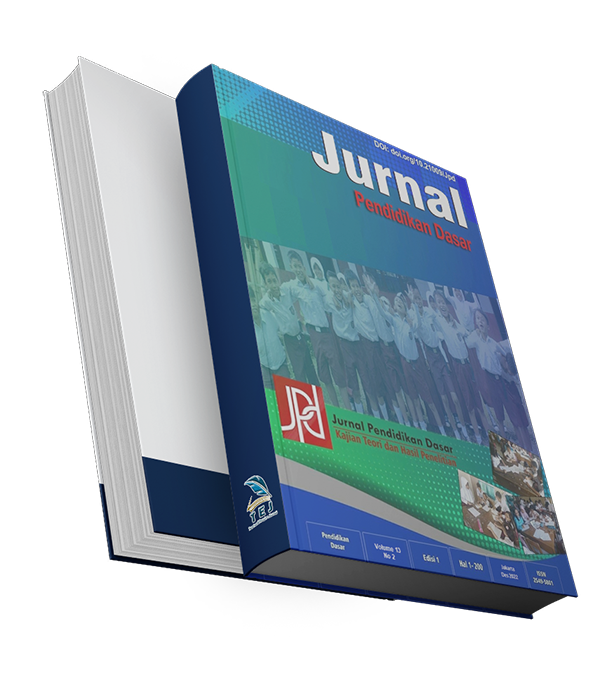PENGEMBANGAN BAHAN AJAR TEMATIK DIGITAL BERBASIS BUDAYA LOKAL UNTUK SISWA KELAS 2 SD
Keywords:
Development, digital thematic teaching materials, local cultureAbstract
Teaching materials are a supporting element for part of the learning process. The limitations of digital thematic teaching materials based on local culture for students in schools are the background for this research. The aim of this research is to produce digital thematic teaching materials based on local culture, especially for grade 2 elementary schools, so the students can enjoy and feel at ease when participating in thematic learning at school. The method applied in the research and development method, referring to the five stages of ADDIE, namely (1) analyzing needs (analysis), (2) designing digital thematic teaching materials based on local culture (design), (3) developing digital thematic teaching materials based on local culture (development), (4) testing digital thematic teaching materials based on local culture (implementation), (5) evaluating products (evaluation). Data collection uses techniques through interviews, observation, questionnaires and documentation. The results of the research can be concluded that the thematic digital teaching materials developed for grade 2 students have good material quality with a score of 83%, while the digital book design has very good quality with a score of 91,9%. This shows that digital teaching materials have very good quality so they can be used in the teaching and learning process. Apart from that, the material in the teaching materials is presented clearly and easily understood by students, is appropriate to their environment, has a positive impact and is a medium that is suitable for use.
References
Angelina Seso, M., Ngurah Laba Laksana, D., & Dua, K. (2018). Pengembangan Bahan Ajar Elektronik Bermuatan Multimedia untuk Siswa SD Kelas IV di Kabupaten Ngada PENGEMBANGAN BAHAN AJAR ELEKTRONIK BERMUATAN MULTIMEDIA UNTUK SISWA SEKOLAH DASAR KELAS IV DI KABUPATEN NGADA. In Journal of Education Technology (Vol. 2, Issue 4).
Arikunto, S. (2014). Prosedur penelitian : suatu pendekatan praktek (Cet.14). Rineka Cipta.
Depdikbud. (2014). Panduan Teknis Memahami Buku Guru dan Buku Siswa.
Dr. E. Kosasih, M. Pd. (2021). Pengembangan Bahan Ajar (B. S. Fatmawati, Ed.; Cet.1). PT Bumi Aksara.
Koentjaraningrat. (2003). Pengantar Antropologi 1. Rineka Cipta.
Riwu, I. U., Dek Ngurah Laba Laksana, & Dhiu, K. D. (2018). Pengembangan Bahan Ajar Elektronik Bermuatan Multimedia Pada Tema Peduli Dasar Kelas IV Di Kabupaten Ngada. Journal of Education Technology, 2, 56–64.
Seso, M. A., Laksana, D. N. L., & Dua, K. (2019). Pengembangan Bahan Ajar Elektronik Bermuatan Multimedia Untuk Siswa Sekolah Dasar Kelas Iv Di Kabupaten Ngada. Journal of Education Technology, 2(4), 177. https://doi.org/10.23887/jet.v2i4.16546
Sugiyono, Prof. DR. (2013). Metode penelitian Penelitian Pendidikan Pendekatan kuantitaif, kualitatif, dan R&D. Alfabeta.
Sunarti, S., & Rusilowati, A. (2021). Pengembangan Bahan Ajar Digital Gerak Melingkar Berbantuan Scratch Berbasis Science, Technology, Engineering, and Mathematics. Unnes Physics Education Journal, 9(3), 283–290. http://journal.unnes.ac.id/sju/index.php/upej
Wijiningsih, N., Wahjoedi, & Sumarmi. (2017). Pengembangan Bahan Ajar Tematik Berbasis Budaya Lokal. Jurnal Pendidikan, 2(8), 1030–1036. http://journal.um.ac.id/index.php/jptpp/
Downloads
Published
How to Cite
Issue
Section
License

This work is licensed under a Creative Commons Attribution 4.0 International License.
Jurnal Pendidikan Dasar





















